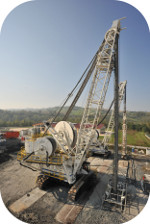Italy's Trevi Group recently accomplished a new feat in slurry walls, hitting a depth of 820 feet (250 meters). The company says it gives designers of major building and infrastructure projects a new tool for their toolboxes.


Representatives from three universities advised Trevi and Soilmec on fluid support, deep soil conditions and the type of concrete.
Trevi Group recently accomplished a new feat in slurry walls, hitting a depth of 820 feet (250 meters). The Italian firm says the new record tops the old one by almost 330 feet.
“Basically, this is a new tool that, until now, was not possible to use,” said Trevi CEO Stefano Tervisani.
Slurry walls enable a range of construction projects in areas where there’s a high water table. One famous example of a slurry wall is the “bathtub” at the site of the World Trade Center.
Tervisani, who has worked with Trevi in various capacities since 1989, says that depth of slurry wall will prove valuable for the infrastructure and transportation sectors. He said one major application would be dam projects, which demand deeper walls.
“I will say it’s really a new possibility for designers.”
Trevi performed this feat in a dedicated testing area near the company’s offices. “Just imagine you do this kind of thing for the first time, you have to design the test properly, ” Tervisani said. He said that engineers with Trevi subsidiary Soilmec designed and manufactured the equipment, and that was the chief challenge for the project.
Soilmec performed this test with its new Tiger 250 Hydromill rig. A smaller Tiger 150 can reach depths of 492 feet (150 meters). Both Hydromills are standard equipped with the Drilling Mate System (DMS) computer controls. The DMS monitors hundreds of parameters in real time during excavation. Operators on the test site could see a wide range of data on site, and all of it was transferred online to a remote control room at Trevi’s offices for backup and review.
Trevi also had scientific support from representatives of the University of Bologna, the Polytechnic University of Turin and the Marche Polytechnic University. University staff advised Trevi on fluid support, deep soil conditions and the type of concrete used in the project. Tervisani called working with the universities “an interesting opportunity to exchange ideas.”
The Tiger 250 performed as designed in tests, and Trevi looks forward to getting it out in the field.
“We are looking at a couple projects, nothing definite yet, hopefully soon,” Tervisani said.
Trevi doesn’t expect to reach lower depths any time soon. “For the time being, it’s fine,” Tervisani said. “This kind of depth-it’s certainly an achievement.”
“Once again, Trevi Group has redefined the limits of underground engineering with solutions that are certain to make an important contribution to highly complex projects previously considered unfeasible.”
Trevi Group touts itself as a worldwide leader in the field of soil engineering. The group was established in Cesena, northern Italy, in 1957 and today does business in more than 80 countries. Its Soilmec division produces and develops plant and machinery for soil engineering.



Report Abusive Comment